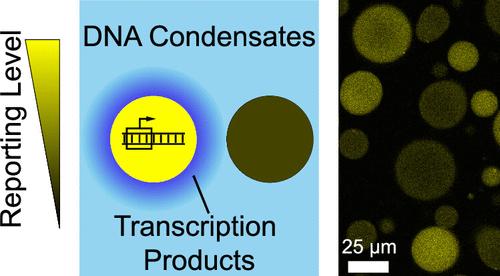当前位置:
X-MOL 学术
›
J. Am. Chem. Soc.
›
论文详情
Our official English website, www.x-mol.net, welcomes your
feedback! (Note: you will need to create a separate account there.)
Spatial Control over Reactions via Localized Transcription within Membraneless DNA Nanostar Droplets
Journal of the American Chemical Society ( IF 14.4 ) Pub Date : 2024-11-20 , DOI: 10.1021/jacs.4c07274 Eli Kengmana, Elysse Ornelas-Gatdula, Kuan-Lin Chen, Rebecca Schulman
Journal of the American Chemical Society ( IF 14.4 ) Pub Date : 2024-11-20 , DOI: 10.1021/jacs.4c07274 Eli Kengmana, Elysse Ornelas-Gatdula, Kuan-Lin Chen, Rebecca Schulman

|
Biomolecular condensates control where and how fast many chemical reactions occur in cells by partitioning reactants and catalysts, enabling simultaneous reactions in different spatial locations of a cell. Even without a membrane or physical barrier, the partitioning of the reactants can affect the rates of downstream reaction cascades in ways that depend on reaction location. Such effects can enable systems of biomolecular condensates to spatiotemporally orchestrate chemical reaction networks in cells to facilitate complex behaviors such as ribosome assembly. Here, we develop a system for developing such control in synthetic systems. We localize different transcription templates within different phase-separated, membraneless DNA nanostar (NS) droplets─programmable, in vitro liquid–liquid phase separation systems for partitioning of substrates and localization of reactions to membraneless droplets. When RNA produced within such droplets is also degraded in the bulk, droplet-localized transcription creates RNA concentration gradients. Consistent with the formation of these gradients, toehold-mediated strand displacement reactions involving transcripts are 2-fold slower far from the site of transcription than when nearby. We then demonstrate how multiple such gradients can form and be maintained independently by simultaneous transcription reactions occurring in tandem, each localized to different NS droplet types. Our results provide a means for constructing reaction systems in which different reactions are spatially localized and controlled without the need for physical membranes. This system also provides a means for generally studying how localized reactions and the exchange of reaction products might occur between protocells.
中文翻译:

通过无膜 DNA Nanostar 液滴内的局部转录对反应进行空间控制
生物分子凝聚物通过分配反应物和催化剂来控制细胞中发生化学反应的位置和速度,从而在细胞的不同空间位置同时发生反应。即使没有膜或物理屏障,反应物的分配也会以取决于反应位置的方式影响下游反应级联反应的速率。这种效应可以使生物分子凝聚物系统在时空上协调细胞中的化学反应网络,以促进复杂的行为,例如核糖体组装。在这里,我们开发了一个在合成系统中开发此类控制的系统。我们将不同的转录模板定位在不同的相分离、无膜 DNA 纳米星 (NS) 液滴中——可编程的体外液-液相分离系统,用于分配底物和定位对无膜液滴的反应。当这些液滴中产生的 RNA 也大量降解时,液滴定位的转录会产生 RNA 浓度梯度。与这些梯度的形成一致,涉及转录本的脚趾介导的链置换反应在远离转录位点的位置比在附近时慢 2 倍。然后,我们演示了多个这样的梯度如何通过同时发生的转录反应来独立地形成和维持,每个转录反应都定位于不同的 NS 液滴类型。我们的结果提供了一种构建反应系统的方法,其中不同的反应在空间上定位和控制,而无需物理膜。该系统还提供了一种通常研究原细胞之间如何发生局部反应和反应产物交换的方法。
更新日期:2024-11-20
中文翻译:

通过无膜 DNA Nanostar 液滴内的局部转录对反应进行空间控制
生物分子凝聚物通过分配反应物和催化剂来控制细胞中发生化学反应的位置和速度,从而在细胞的不同空间位置同时发生反应。即使没有膜或物理屏障,反应物的分配也会以取决于反应位置的方式影响下游反应级联反应的速率。这种效应可以使生物分子凝聚物系统在时空上协调细胞中的化学反应网络,以促进复杂的行为,例如核糖体组装。在这里,我们开发了一个在合成系统中开发此类控制的系统。我们将不同的转录模板定位在不同的相分离、无膜 DNA 纳米星 (NS) 液滴中——可编程的体外液-液相分离系统,用于分配底物和定位对无膜液滴的反应。当这些液滴中产生的 RNA 也大量降解时,液滴定位的转录会产生 RNA 浓度梯度。与这些梯度的形成一致,涉及转录本的脚趾介导的链置换反应在远离转录位点的位置比在附近时慢 2 倍。然后,我们演示了多个这样的梯度如何通过同时发生的转录反应来独立地形成和维持,每个转录反应都定位于不同的 NS 液滴类型。我们的结果提供了一种构建反应系统的方法,其中不同的反应在空间上定位和控制,而无需物理膜。该系统还提供了一种通常研究原细胞之间如何发生局部反应和反应产物交换的方法。


















































 京公网安备 11010802027423号
京公网安备 11010802027423号